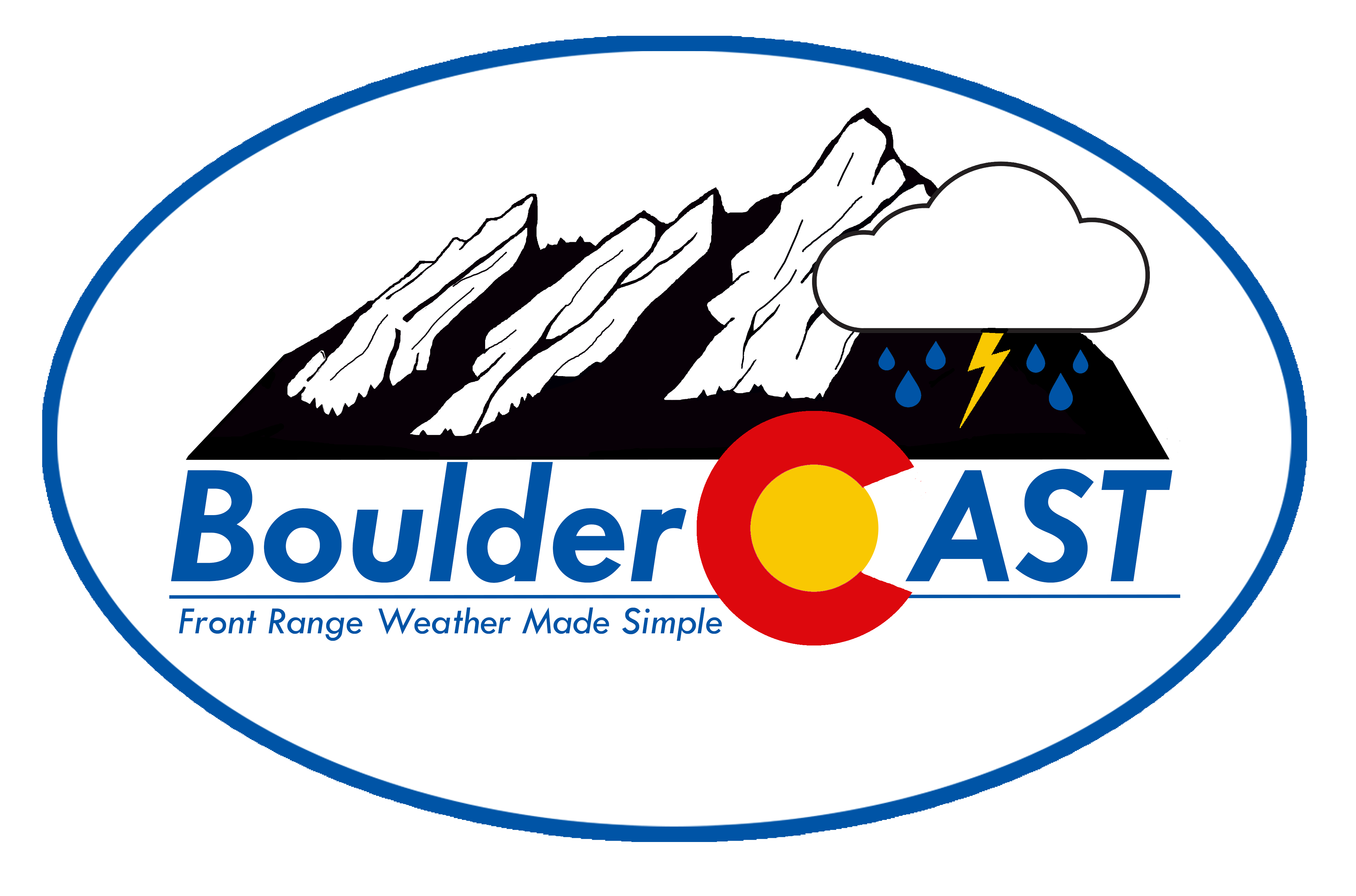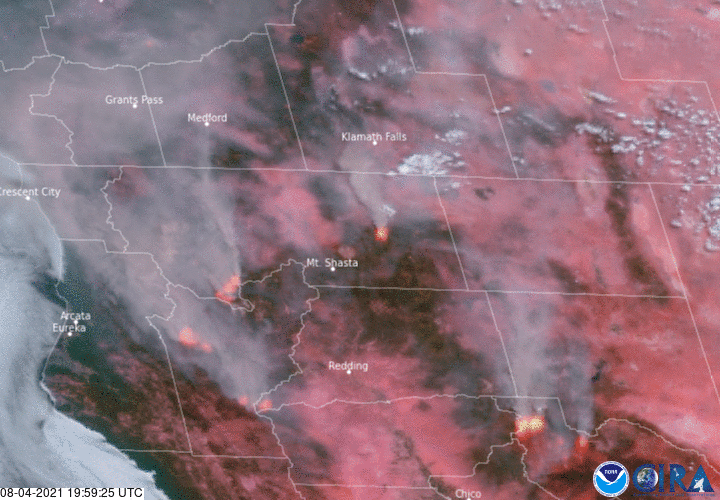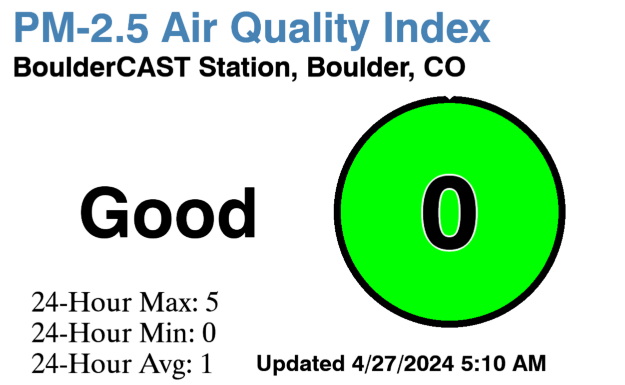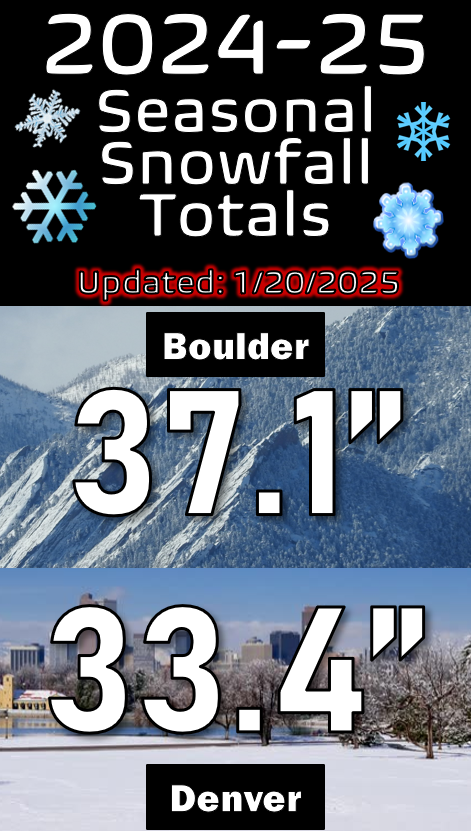What a wild weekend in weather it was across the Front Range! A daunting wall of wildfire smoke took over the entire state of Colorado on Saturday and has blanketed our area ever since. When will the smoke clear out and our air quality improve, how hot will it get this week, and what the heck happened to the monsoon? Read on to find out.
This week’s highlights include:
- A thick wave of smoke rolled across the entire state of Colorado this past weekend causing reduced visibility and poor air quality
- Smoke will remain socked in early in the week, but could improve mid to late week as the primary smoke plume gets redirected away from Colorado
- Hot, smoky and mostly sunny weather is expected through the week with highs generally in the 90’s
- The monsoon continues its hiatus with little to no chance for rainfall this week
DISCLAIMER: This weekly outlook forecast is created Monday morning and covers the entire upcoming week. Accuracy will decrease as the week progresses as this post is NOT updated. To receive daily updated forecasts from our team, subscribe to BoulderCAST Premium.
A literal wall of smoke slammed the Front Range!
The highlight of the weekend in the Denver area was of course was the 10,000-foot high wall of smoke which inundated the Front Range on Saturday. We issued a stark warning about this unique event nearly 24 hours in advance as a low pressure system to the northwest in Idaho was gathering-up a massive amount of wildfire smoke with an advertised track headed directly for our area. The smoke took its time to arrive, which is something we noted could happen as the wave of smoke trekked through the Mountains to the west towards Denver. The geocolor satellite animation below shows the sun rising Saturday morning and the smoke’s swift sweep across the entire state of Colorado like a tsunami!

GOES-West visible satellite image animation from Saturday showing the smoke wall blowing across Colorado
We gave it our best, but our suggested hashtag of “Smokeggedon” just never caught on, despite the apocalyptic-esque conditions we predicted for Saturday and which ultimately did verify. This was the view from Boulder around mid-day!
During the worst of it, air quality indices for particulate matter smaller than 2.5 micrometers in diameter (PM2.5 AQI) peaked during the middle of the afternoon on Saturday at values between 160 and 190, solidly in the “Unhealthy” category.
2:30PM Smoke Update: PM2.5 Air Quality Indices have been very slowly climbing for hours! #COwx #Smoke
😢Boulder: 180
😢Erie: 180
😢Rocky Mtn NP: 175
😢Nederland: 175
😢Louisville: 175
😢Broomfield 175
😢Longmont: 175
😢Denver: 170
😢Aurora: 170
😢Golden: 165
😢Ft Collins: 165 pic.twitter.com/UIfX2DjVPt— BoulderCAST Weather (@BoulderCAST) August 7, 2021
From observations taken at our station in Boulder, Air Quality remained “Unhealthy” for about 26 consecutive hours before things cleared out a little and we dropped back below the 150 threshold.
When the sun rose Sunday morning, a thick blanket of smoke was clearly visible from space, with only our state’s tallest peaks trying to poke through. Air quality improved somewhat on Sunday, but it was still not great as lingering smoke plagued the region.

GOES-West visible satellite image from Sunday morning showing smoke blanketing all of Colorado and the surrounding states (8/8/21)
As of Monday morning, we’re seeing AQIs around 130 in Boulder, and this has been slowly climbing all morning long. This is better than it was over the weekend, but still far from good.
Poor air quality is present across the entire Front Range this morning….
…and also across the entire state of Colorado….
…and a large chunk of the western United States, too. Ugh! At least we are not alone in this…
Not surprisingly, Air Quality Alerts remain in effect for the entire state for wildfire smoke. For the Front Range, the threat also includes daytime ozone.
It’s also worth pointing out that you won’t be able to escape the smoke by heading to the mountains either. Sometimes the smoke or pollution layer can be very shallow and may only sit over the Denver area. However, that’s not the case right now. This is a deep blanket of smoke that is all encompassing. At times the smoke may be worse in the Mountains, while at other times this week it will be worse across the Plains, but overall don’t expect any reprieve in one location or the other.

Cross-sectional HRRR smoke forecast for Monday morning. The top of the smoke layer is near 21,000 feet elevation (6.5km), so there’s no escaping it by going to the Mountains!
Brace for a hot & smoky week ahead
OK. Let’s get into the weather for the upcoming week. We wish we could pass along definitive information that the smoke will clear out soon and that our air quality will get drastically better, but that’s just not the case. We know that the next 48 hours will certainly be smoky across the entire Rocky Mountain State. This 48-hour window is the maximum range of the best-in-class smoke prediction forecasts that are available from the HRRR weather model. The latest total smoke forecast for Colorado from this high-resolution model is shown below. You might notice a few pockets of lower smoke at times in the forecast here and there, but largely the state will remain blanketed in thick smoke through Tuesday night.
Beyond the range of this short-term smoke forecast, we need to do a little bit of educated guesswork to determine how much smoke will be across our area the rest of the week from Wednesday onwards. Important factors in this process include:
- Pinpointing where the largest active wildfires are burning
- Predicting how low- and mid-level winds in the atmosphere across the western United States will coagulate and transport the resulting smoke
Right now, the largest source of smoke across the West is definitely in northern California where a handful of absolutely massive wildfires are currently raging. The five or so fires shown in the animation below have burned more than 600,000 acres combined. The Dixie Fire, the one in the bottom right, is the largest at nearly 475,000 acres. This particular fire has been creating towering pyrocumulus clouds day after day for weeks now. These are highly localized, stationary thunderstorms that develop on top of large wildfires, fueled not by natural atmospheric instability, but instead by the heat from the fire itself. The smoke generated by the fires in northern California will be the keystone of our medium-range smoke outlook, though other smaller fires across Washington, Oregon, Montana and southern Canada will contribute some smoke this week as well.
Let’s look at the transport of the California smoke to northern Colorado and how that mechanism might evolve in the coming days. Early in the week, there is essentially a direct atmospheric pipeline from northern California to the Front Range. This is the exact setup we saw this past weekend during Smokeggedon and is the main reason smoke concentrations will remain quite high on Monday and Tuesday.
However, as we get towards the middle of the week, things begin to change for the better. By Wednesday, high pressure will start to built into California from the west, with winds beginning to relax and become more southerly, or at least more erratic. A key factor here is that some of the smoke will start to get pulled westward and out over the Pacific Ocean. Smoke going that way is smoke not coming our way. It’s a simple as that.
By late in the week on Friday, things really start to look up….well, about as much as they can under these circumstances. High pressure will build further east and should be situated somewhere across western Colorado or Utah by midday Friday with moderate southerly flow pushing across the fiery zone in California. This setup will usher a bulk of the smoke northward into the Pacific Northwest and then eastward across Montana. Smoke should begin to lighten up across the Front Range by Friday and Saturday as a result.
Remember, this is just our best-guess forecast. The exact weather pattern later this week with the developing high pressure will be crucial and is not set in stone this far out. We also must consider the entire system is in motion at all times. Depending on wind speeds, it could take anywhere from 1 to 4 days for smoke produced in California to show up on our doorstep here in Denver. This also doesn’t consider any potential new fires that spawn, which is always a risk when 96% of the West is experiencing moderate or worse drought. Take this with a grain of salt, but yes we are expecting smoke to decline through the week with improving air quality, but there are a few more nasty days ahead!
Outside of the smoke, there’s really not much else going on this week in Colorado weather. We’ve already shown you the large-scale atmospheric pattern in the panels above and how it evolves through the week. Early on there will be a trough skirting along the far northern tier of the United States. This will have little consequence for our area as it is too far north. There’s just a slight chance of thunderstorms north and east of the Denver area on Monday, with a risk of severe weather even further east in Nebraska and Kansas. Denver and Boulder will be dry on Monday in the 90’s, but some virga is possible during the late-day period. As a reminder, virga is rain that evaporates before reaching the ground and can be visible as small streaks falling out of the dark clouds above.
Tuesday will be sunny, smoky and cooler, though we challenge you to perceive this slight cooldown. Highs are still expected to reach the lower 90’s.
Wednesday shall be completely dry with lots of sun. Hopefully we start to see some real improvements in the smoke at this point, but do expect another smoky day overall. High temperatures soar into the middle to even upper 90’s in spots. This will be close to record heat for the Front Range, but the added smoke and marginal weather pattern suggest to us most areas should land a few degrees shy of existing records. For Boulder, the August 11th record high is 97°F set back in 1959.
Thursday and Friday will be a little bit cooler as flow turns northwesterly again. We’re still expecting highs around 90 degrees both days which is just slightly above normal for mid-August. During this time, we’ll start to see some hints of subtropical moisture work back into the area as well, though it will be limited. This should fuel isolated thunderstorms in the Mountains and Foothills, with some chance that this rain could extend out over the lower elevations as well. For now, we’re only including a 10% chance of storms Thursday and Friday for the Denver Metro area, which should clue you into our pessimism for wet weather to end the week.

GFS model total precipitation forecast through Saturday evening. Minimal precipitation is expected across northeast Colorado this week.
The summer monsoon pattern has dried up across the Desert Southwest during the month of August and that doesn’t really appear to change much moving forward. Some moisture will work into Arizona and California in the coming days associated with an area of low pressure. Eventually that moisture and weak monsoonal flow will recirculate around high pressure to reach Colorado this weekend. Still, it’s not a direct monsoon pipeline and rain chances appear slim for the foreseeable future in the Front Range. We may see a slight uptick for the upcoming weekend, but that is a big maybe right now.

GFS ensemble precipitable water anomaly animation through the end of the upcoming weekend. The monsoon plume is suppressed somewhat and directed westward from Colorado. Not good.
Stay up to date with Colorado weather and get notified of our latest forecasts and storm updates:
We respect your privacy. You can unsubscribe at any time.
.
Forecast Specifics:
Monday: Increasing clouds with milky skies from the smoke. A slight chance of a late-day shower east of Denver, but dry around Boulder. Highs in the low to middle 90’s on the Plains and lower 80’s in the Foothills.
Tuesday: Mostly sunny and smoky with just a few afternoon clouds. Temperatures in the lower 90’s for the Plains with upper 70’s in the Foothills.
Wednesday: Mostly sunny, dry, hot and likely still fairly smoky. Highs in the middle 90’s on the Plains with lower 80’s in the Foothills.
Thursday: Morning sun with isolated late-day thundershowers. The chance is highest across the higher terrain. Highs in the lower 90’s across the Plains with lower 80’s in the Foothills.
Friday: Mostly sunny with just a slight chance of an isolated afternoon/evening storm. Temperatures cooler in the upper 80’s across the Plains with middle 70’s in the Foothills.
Mountains: Like the lower elevations, smoke will be the story this week in the Mountains as well. Temperatures will be above normal with generally light winds out of the west or northwest. Storms will be few and far between, though expect isolated coverage Tuesday and beyond, especially across southern Colorado.
Help support our team of Front Range weather bloggers by joining BoulderCAST Premium. We talk Boulder and Denver weather every single day. Sign up now to get access to our daily forecast discussions each morning, complete six-day skiing and hiking forecasts powered by machine learning, first-class access to all our Colorado-centric high-resolution weather graphics, bonus storm updates and much more! Or not, we just appreciate your readership!
.
Spread the word, share the BoulderCAST forecast!
.





























You must be logged in to post a comment.